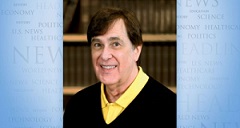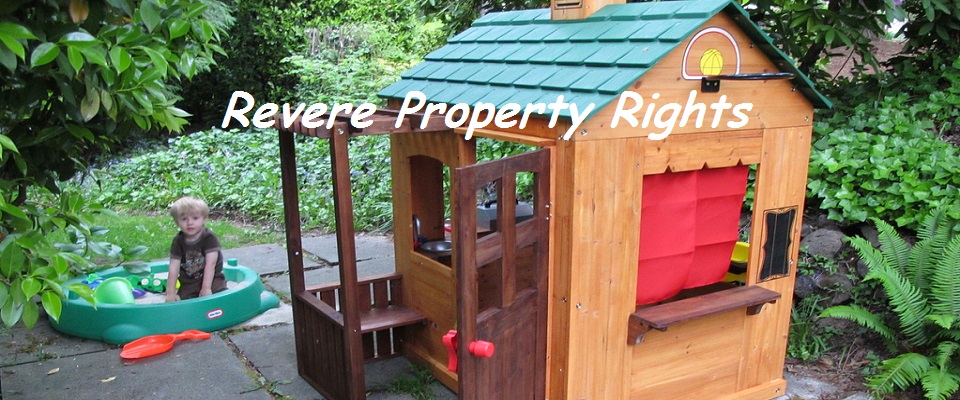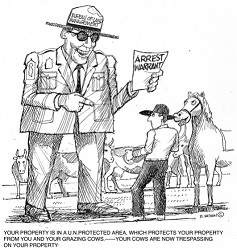I pay taxes and I’ll bet you do too. Our taxes are used, in part, to help those in the country who need a little extra assistance for basic necessities like housing and food. The federal government would have us believe that paying a little more in taxes would go a long way towards reducing poverty in this country. I’ve never believed that argument. I’d like to share with you an article I read in the New American, written by Tom DeWeese, published on December 4,2012, which explained better than I ever could the REAL relationship between private property and poverty.
Private Property Ownership Is the Only Way to Eradicate Poverty
Poverty. It’s the excuse for nearly every government spending program. Help the poor. Tax the Rich. Get the One Percent. How dare they get so wealthy while everyone else suffers!
And what is the preferred way to eliminate poverty? Redistribution of wealth. It is the force behind the Occupy Wall Street movement, Agenda 21 and its Social Justice schemes, nearly every poverty program of the Federal government, and even most charitable poverty programs. 
These schemes are all the same. Take money from the producers and give it to the non-producers. Yet, as billions of dollars are taken for the “cause,” poverty steadily increases. If one truly wants to help eliminate poverty, perhaps it’s time to rethink the process. To start, ask the question — why are some nations (and individuals) wealthy and others so poor?
There are many efforts underway to focus attention on world poverty. In a world of massive government spending that is supposed to be used to help the poor, the statistics on global poverty are staggering. According to the United Nations Millennium Project, there are currently 1.2 billion people living in poverty. Fifty thousand deaths per day occur worldwide as a result of poverty. Every year more than 10 million children die of hunger and preventable diseases. More than half of the world’s population lives on less than $2 per day and 800 million people go to bed hungry every night.
To combat the situation, there are massive efforts underway, from churches and charitable organizations to local, state, federal, and international government programs designed to eradicate poverty. Billions of dollars in foreign aid have been distributed to countries around the world to help feed the poor. Poverty reduction targets have been set. International goals have been announced. Deadlines have been determined. Agreement has been reached by every national leader that poverty must be eradicated.
There are faith-based programs designed to feed the children; education programs designed to create awareness of poverty and starvation; corporate programs designed to enhance global development, which would help to create business or bring existing corporations into nations to provide jobs; and government programs designed to build hospitals, schools, and improve healthcare and education. Charitable contributions and government money, either from the local level or through foreign aid, are the main source of funds for these efforts.
Yet little progress is being achieved as, in fact, the problem continues to escalate. There is an ever-growing disparity between rich and poor. Why?
To date, nearly every effort to eradicate poverty has focused on temporary relief of the suffering rather than getting to the root of the poverty and creating real solutions to actually eradicate poverty permanently. The result of such efforts, while well intentioned, and perhaps necessary in the short run to assure the poor are at least kept alive, will not solve the problem of poverty. In fact, such programs may actually make the situation worse.
Frankly there is not much new in this type of activity. For more than 50 years governments and charities have been focused on rushing aid to the poor and starving. Yet none of these efforts address the basic reason poverty exists in the first place. The solutions which call for more and more aid simply respond to the visual effects of poverty such as starvation, ignorance, and poor health. None truly address the cause. As a result, rather than easing the situation, the number of poor people continues to grow.
Most of the current anti-poverty efforts focus on redistributing funds from wealthier nations to poorer ones, either through mandatory taxation or charitable donations. This system ignores the fact that tomorrow the poor need to be fed again. Taxpayers or the voluntary donor must dig into his own funds yet again to help. The process is repeated daily, each time the poor recipient is only temporarily helped, as the tax payer or the donor become poorer themselves. Meanwhile, as massive funds are moved in and out of governments, bureaucracies are institutionalized to run the system. More and more money goes to feed the machinery of poverty than gets into the hands of the intended poor. Such a system sustains poverty rather than eradicates it.
Meanwhile, some corrupt and totalitarian governments also learn how to divert funds into their own coffers, again, depriving the poor of their daily bread. A system of bribes and local corruption often exists, making it nearly impossible for average citizens to receive government services. Such a system forces many of the poor to live outside of society in a virtual underground economy. This actually serves to sustain poverty against the efforts of those trying to eradicate it.
In addition, some international policies essentially institutionalize poverty. Policies which prevent or severely restrict development and energy use result in the violation of the most basic human rights, denying economic opportunities and the chance for better lives, the right to rid their countries of diseases that were vanquished long ago in Europe and the United States. For example, lack of electricity means no water purification or sewage treatment, no power for offices or hospitals, and no stoves to replace pollution-belching, lung-disease-causing open fires.
Yet, as the UN, through its Millennium Project, tells us that the goal is to eradicate poverty by the year 2015, the UN and nations including the United States, promote policies that make such goals impossible, Specifically, they promote Sustainable Development, which supporters say must stop the spread of human advancement in the name of protecting the environment. According to the doctrine, the poor in third world nations need to just do without electricity, clean water or modern development, for that is sustainable! Shameful.
To enforce such policy world wide, the UN, at the Rio+20 Summit held this past summer, in the name of ending poverty sought to enforce a tax on every developed nation equal to 0.7 percent of their gross national product. To every American, that is a redistribution of wealth equal to $1,325 per year for an American family of four. The money, they say, will end poverty and protect the environment.
And to get the job done, using that money, the UN will find it necessary to create a new global council to oversee it all; new UN agencies to administer the programs, budgets, and power; and “genuine global actions.”
In 2006, when I debated the head of the UN’s Millennium Project at Cambridge University in England, I said to him over dinner before the debate, “You realize you don’t have a chance to end poverty by 2015 by using redistribution of wealth, don’t you?” He said, “Yes, I know.”
The Real Way to End Poverty
It is becoming increasingly clear that poverty will never be eradicated unless those working on the problem will allow themselves to look for a drastically new way to attack it. Simply put, rather than constantly applying band-aids to the effects of poverty, they must look for the cause and fix it.
One must first look at the world and see where wealth is created and why it is so. The greatest example of wealth creation is obviously the United States. It is the beacon of wealth and freedom for the entire world. Most people in the world envy America’s wealth and seek ways to share it, yet very few look at how the nation got its wealth, or attempt to copy its system for success.
Why did the United States become so wealthy? Was it the possession of vast natural resources? Africa has more. Was it the existence of greater industry? Japan has more. Was it the existence of a superior education system? The United States now ranks below the top ten nations in education.
The reason the United States has led the world in wealth, standard of living, and abundance is that the average resident of the United States has had the ability and the opportunity to invest and produce capital.
Why could ordinary citizens of the United States produce their own capital to create personal wealth, while most of the rest of the world failed at such an attempt? The answer is actually very simple. The United States created a very easy, immediate, complete system for recording and securing ownership of private property.
Peruvian economist Hernando de Soto explains the root of American wealth in his book, The Mystery of Capital. De Soto asks, “Why does Capitalism thrive only in the West, as if enclosed in a bell jar?”
Capital, he argues, “is the force that raises the productivity of labor and creates the wealth of nations, It is the lifeblood of the capitalist system, the foundation of progress, and the one thing that the poor countries of the world cannot seem to produce for themselves.”







